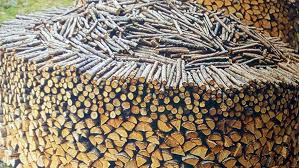Como esta semana celebramos el Día das Letras Galegas, queremos hablar de un libro que le hubiese encantado al propio Carlos Casares. Se trata de El libro de la madera, del noruego Lars Mytting, un manual sobre el arte del corte, apilado y secado de la madera que se ha convertido en un inesperado best seller internacional. En un primer nivel de lectura, el libro de Mytting es simplemente un resumen de una actividad tradicional típica en los países nórdicos, en los que la mayoría de los hogares se calientan, todavía hoy, con madera. Pero la atención que el autor presta a esta actividad, y los valores tradicionales que se asocian con ella descubren toda una filosofía vital.
Así, El libro de la madera supone una reivindicación del homo faber, del hombre capaz de hacer cosas por sí mismo. Buscar leña y quemarla para obtener calor nos conecta con nuestros ancestros prehistóricos y resulta más gratificante que darle al botón de la calefacción. En un mundo de automatismos, una actividad como cortar leña reivindica nuestro papel activo. Además, cortar leña es una actividad cíclica. Hay que salir al bosque, buscar el árbol apropiado, talar, transportar, trocear y apilar para dejar secar. Cortamos hoy la leña que quemaremos en unos meses, y nos calentamos con la que preparamos hace tiempo. En un mundo de prisas e inmediatez, esta actividad nos reconecta con los ritmos de la naturaleza y nos invita a tomarnos nuestro tiempo.
Pero sobre todo, la obra de Mytting es una reivindicación de la madera como fuente de energía inagotable y renovable y del bosque como entorno natural. Frente al falso ecologismo que en ocasiones llega desde Hollywood, según el cual cortar un árbol es poco menos que un acto criminal, Mytting nos recuerda el modelo de cohabtación continuada que se puede establecer entre los humanos y el bosque, talando y plantando, explotando y renovando, de modo que el ciclo resultante mantenga el equilibrio de la Naturaleza. Y la madera protagoniza sus páginas como un elemento fascinante, lleno de vida, de energía. Tipos de corteza, diferentes fibras, pesos, densidades... en las páginas de Mytting, el elemento que nos ha acompañado de manera persistente a lo largo de la Historia se presenta como un elemento indispensable también para el futuro.
WHAT WOOD TEACHES TO US
As
this week we celebrate the Día das Letras Galegas, we want to talk
about a book that would have enchanted Carlos Casares himself. It
is The Book of Wood, by norwegian writer Lars Mytting, a manual on the art of
cutting, stacking and drying wood which has become an unexpected
international best seller. At
a first reading, Mytting's book is simply a summary of a typical
traditional activity in the nordic countries, where most households are
still heated with wood. But the attention the author gives to this activity, and the
traditional values associated with it, reveal a whole philosophy.
Thus, The Book of the Wood supposes a vindication of homo faber, the man able to do things by itself. Finding
firewood and burning it for heat connects us to our prehistoric
ancestors and is more rewarding than just pressing the heating button. In a world of automatisms, an activity like chopping firewood claims our active role. In addition, chopping firewood is a cyclical activity. You have to go out into the woods, find the appropriate tree, cut, transport, stack to dry. Cut today the wood that will burn in a few months, and we warm up with the one we prepared long ago. In a world of haste and immediacy, this activity reconnects us with the rhythms of nature and invites us to take our own time.
But above all, Mytting's work is a vindication of wood as an inexhaustible and renewable source of energy and of the forest as a natural environment. In the face of the false ecologism that sometimes comes from Hollywood, according to which cutting a tree is little more than a criminal act, Mytting reminds us of the model of continued cohabitation that can be established between humans and the forest, cutting and planting, renewing, so that the resulting cycle maintains the balance of Nature. And the wood stars as a fascinating element, full of life, energy. Types of bark, different fibers, weights, densities ... in the pages of Mytting, the element that has accompanied us in a persistent way throughout history is presented as an essential element also for the future.



No hay comentarios:
Publicar un comentario
Deja tu comentario en As Salgueiras